
TTS Roadsport Workshop Services - Wheel Alignment

Wheel Alignment - Glossary
An explanation of the different alignment angles can be found by clicking one of the following links:
Camber | Caster | Toe | KPI or SAI | Thrust Angle | Setback

What is Camber
Camber increases or decreases the tyre's grip on the road by the wheel not being upright, when viewed from the front or rear.
Correct camber is a design requirement and incorrectly set at best will cause tyre wear but at worse could seriously compromise the overall handling characteristics of the car - even making it dangerous.
Sign definition
Positive camber is when the top of the wheel leans away from the car.
Negative camber is when the top of the wheel leans towards the car.
Zero camber is therefore when the wheel is fully upright.
Cross Camber
Often overlooked and often resulting in vehicle pull.
Cross camber is the difference in camber from one side to the other, if each wheel is itself correctly in tolerance, but at opposite ends of the scale, then the cross camber will be high and might need attention. Some manufactures now specify this value.
The car will tend, as a general rule, to pull to the side with the least negative or most positive camber.

What is Caster
Caster is the forward or rearward tilt of the steering axis, in reference to the vertical when viewed from the vehicle side.
Positive caster is where the steering axis is sloped towards the rear.
Negative caster (not common) is where the steering axis is sloped towards the front.
Why
High positive caster makes the steering heavier but results in the car remaining better in a straight line at speed. Shopping cars, Renault 5, Ford Fiesta, etc have caster values close to zero. BMW 7 series or Mercedes 500 have high positive caster to assist in keeping straight on the autobahn!
Cross Caster
Cross caster is a difference in caster from side to side. As a rule of thumb a car will steer toward the side with the least caster.

Sign convention
Positive Toe is the leading edge of the wheels closer together.
Negative Toe is the leading edge of the wheels further apart.
Our advice would be not to refer to toe as toe-in. For example negative toe-in is toe out! Better to simply say the car has negative toe or is toed out.
Individual Toe
Individual toe is measured from the vehicle centre line.
If a total toe figure is given divide it and its tolerance by two to gain the individual value. Individual toe can be thought of as a per wheel value.
i.e. Total toe + 0deg 30min tol. +/- 0deg 15min
Individual toe + 0deg 15min tol. +/- 0deg 7.5min
Units of measurement
Toe can be measured in mm or degrees and minutes.
A common mistake is to simply state a toe value, i.e. Ford Sierra +2mm.
However there are various worldwide conventions as to where this is measured. For Europe the norm is to measure at the edge of the wheel rim and hence a diameter of the rim must be specified.
So to correctly specify the toe for the Ford Sierra it should be stated as +2mm for a 14" rim.
The problem is that fitting different size wheels would result in a different toe figure being required!
The solution is to always measure and record the toe as degrees and minutes. (Or decimal degrees if you prefer). This value is irrespective of wheel rim size fitted and is less liable to error.

Cars generally no longer have kingpins and hence the term KPI (King Pin Inclination) is outdated.
SAI stands for Steering Axis Inclination and it will be referred to subsequently by this.
When viewed from the front the SAI is the inclination of the strut top towards the centre of the vehicle, and in all cases is positive.
SAI is not altered in the aftermarket, only returned to the factory setting, perhaps following accident damage. SAI gives driver feel to the steering and assists in unwinding the steering after steering lock has been applied, bringing the steering back to the straight ahead.
Included angle
Adding together the SAI and the Camber gives the included angle.

Thrust angle (other than zero) occurs when the individual rear toe values are unequal.
The easiest example to imagine is for a car with a live rear axle (one piece) that has the axle fitted crocked in the body such that one rear wheel has toe-in and the other one has toe-out.
Thrust line is an angle of the resultant drive direction compared to the vehicle centreline. Cars driven with high thrust angles may appear to 'crab'.
On cars, which have independent suspension, some are individually adjustable for toe, which can then be used to correct both the toe-in and thrust line together.
Thrust angle should where possible always be adjusted to zero, to coincide with the vehicle centreline.
Sign definition
A positive thrust angle is one that points to the left.
A negative thrust line is one that points to the right.
Straight steering wheel
Errors in the steering wheel being straight on road test can be the rear toe being wrong and a high thrustline. (As well as the front track-rods being adjusted un-equally or steering wheel having been fitted incorrectly).
Computerised aligners measure and record the thrustline and at the adjustment stage will set the steering wheel level allowing for any thrust angle. It is for this reason that the adjustment step on all aligners takes you first through rear toe adjust, to give you the opportunity of reducing the thrust angle as far as possible, before moving on and adjusting the front toe and steering wheel.

Setback is the relative positions of the two wheels on an axle.
Setback can be given in mm or as an angle i.e. degrees and minutes.
Sign convention
Negative setback is the right wheel back (relative to the left)
Positive setback is the left wheel back (relative to the right)
Which wheel
Setback will not tell you which wheel is in the correct position only the relative position. So is that wheel forward or the other wheel back? Measuring wheelbase or caster can help.
Tolerances
Interestingly very few manufactures give a tolerance, so the value should be used as a guide in that if you measure a high set back, there may then be something else which will measure out side the tolerance. One example of this would be the caster angle. If one front wheel has been knocked back giving it high set back then the caster angle would also measure low, possibly even out of tolerance on this side.

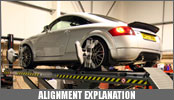 |
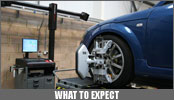 |
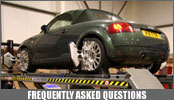 |
||
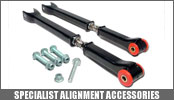 |
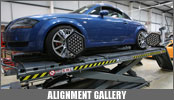 |
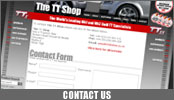 |
||

